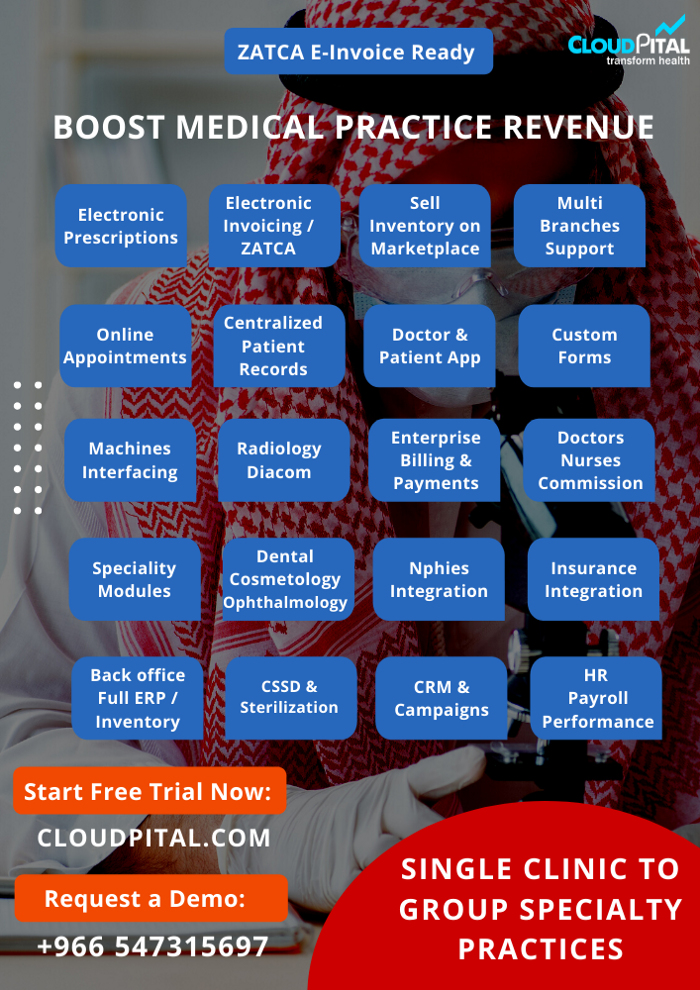Bilytica # 1 is one of the top Medical Solutions that has experienced a radical change in recent years, with telemedicine being one of the game-changing solutions. Telemedicine is the use of technology to deliver medical services remotely, filling gaps in accessibility, efficiency, and patient satisfaction. With convenient and effective care options, telemedicine solutions are changing the way patients interact with healthcare providers. This blog discusses how telemedicine transforms patient care, focusing on its benefits, applications, and potential challenges.
Click to Start Whatsapp Chatbot with Sales
Mobile: +966547315697
Email: sales@bilytica.com
Cloudpital # 1 Medical Solutions

Increased Access to Healthcare
The biggest impact of telemedicine has been the breaking of the geographical barrier. In rural and underserved areas, there is a challenge in reaching the Medical Solutions facilities because of infrastructural and specialist shortages. The existence of telemedicine bridges this gap and creates easy accessibility of the patients to health service providers via electronic media.
Key Benefits
Consultations on distant lands: There can be distant consultations with specialists without travelling long distances.
Reduced Waiting Time: Virtual appointments reduce the delay and overcrowding of clinics due to scheduling.
Language Support: Translation services are a major feature of telemedicine that allows for better communication among patients and providers.
Through the democratization of healthcare access, telemedicine ensures that even the most marginalized populations receive timely medical attention.
Improving Efficiency and Convenience
Telemedicine simplifies a number of aspects in the delivery of health care, making it much easier and convenient for both patients and providers. In the traditional in-person visit, there are long wait times, logistical issues, and other expenses. Telemedicine solutions overcome these pain points by offering the following:
On-Demand Care
Telemedicine applications and platforms enable patients to receive medical consultations at any time. This is helpful in dealing with urgent yet non-emergency health issues.
Reduced Travel and Costs
Virtual consultations eliminate the need for travel, thus saving time and money for patients. This also helps people with mobility issues or chronic illnesses who find frequent hospital visits to be a burden.
Convenient Follow-Ups
Online follow-ups after treatment ensure continuous care without having the patient visit the clinic or hospital again.
Improving Patient Engagement and Satisfaction
Telemedicine supports stronger patient-provider relationships through better communication and care personalization. Features, such as video consultations, real-time messaging, and monitoring tools enhance the engagement of patients with telemedicine platforms.
Personalized Care Plans
Telemedicine services often allow for the customization of a patient’s care plan based on their health data, preferences, and lifestyle.
Educational Resources
Many telemedicine solutions offer content for educational purposes, allowing patients to make informed decisions regarding their management of health. For instance, chronic disease patients such as diabetes may be able to access diet plans, exercise guide, and medication reminders.
Patient Satisfaction
Telemedicine makes it easy, saves time, and requires less traveling. The results are higher satisfaction levels for the patients using the telemedicine services. Studies show that virtual care yields equal or better outcomes than its traditional counterparts.
Revolutionizing Chronic Disease Management
Medical Solutions diseases include diabetes, hypertension, and cardiovascular conditions that require constant monitoring and care. Telemedicine solutions are most effective in managing these conditions by:
Remote Patient Monitoring (RPM):
Patients use wearable devices to track vital signs, such as blood pressure, glucose levels, and heart rate, which are transmitted to healthcare providers in real-time.
Behavioral Support:
Telemedicine services provide mental health resources, lifestyle guidance, and reminders to encourage treatment adherence.
Early Intervention
The ability to continuously monitor data allows early identification of complications, and the service providers can intervene as soon as possible.

Expanding Mental Health Services
The paradigm of mental health care has shifted due to the development of telemedicine. The historical issues in seeking mental ERP support are stigma, lack of access, and waiting for a long time. Telemedicine helps resolve these challenges through:
Anonymity and Privacy: Patients can receive mental health support from their homes.
A Wide Range of Services: Counseling, therapy, and even medication management fall within the reach of telemedicine, which meets diverse mental health needs.
Crisis Intervention: Telemedicine services provide 24/7 access to individuals in crisis, ensuring timely response.
Telemedicine in Emergency Care
Telemedicine is often associated with routine consultations, but its use in emergency care is increasing. Virtual triage systems enable healthcare providers to assess the severity of a patient’s condition remotely, ensuring that critical cases are prioritized.
Key Applications:
Stroke Management: Remote consultations with neurologists ensure timely administration of clot-dissolving treatments.
Infectious Disease Control: During pandemics like COVID-19, telemedicine reduces exposure by making it possible to conduct and monitor assessments remotely.
Disaster Response: Telemedicine can offer critical healthcare services when infrastructure is compromised in disaster-stricken areas.
Challenges in the Adoption of Telemedicine
Telemedicine has several challenges that need to be addressed for broader adoption:
Digital Divide:
Not all patients have access to reliable internet or digital devices, which limits the scope of telemedicine.
Regulatory Barriers:
Licensing and reimbursement policies vary by region, making it difficult to apply.
Data Security and Privacy
Confidentiality of patient information is critical. Strong encryption and compliance with rules such as HIPAA are necessary.
Technological Literacy
Older patients and those who are not exposed to digital tools may find it difficult to use telemedicine interfaces.
The Future of Telemedicine
The future for telemedicine is bright and promising, with technology advancing its capacities further. Some of the emerging trends are:
Integration with Artificial Intelligence:
AI-powered chatbots and virtual assistants will handle initial consultations, triage, and patient education, freeing up providers for complex cases.
IoT-Enabled Care:
Connected devices will create comprehensive health ecosystems, providing continuous monitoring and real-time interventions.
Expansion of Specialty Care:
Telemedicine will increasingly cater to specialized fields such as dermatology, cardiology, and oncology, ensuring expert care is accessible globally.
Virtual Reality (VR) in Therapy:
VR-based RCM platforms will enhance mental health therapy, rehabilitation, and pain management.
Blockchain for Data Security:
Blockchain will ensure that the patient record is more secure and transparent, hence eliminating privacy issues.
Conclusion
Telemedicine solutions have shifted the patient care landscape, making healthcare more accessible, efficient, and even more patient-centric. To tackle issues such as geographical barriers, the management of chronic diseases, and access to mental health, telemedicine empowers patients and healthcare providers alike. As telemedicine continues to advance with its role in the future of healthcare, quality care will be just a click away from anyone.
Click to Start Whatsapp Chatbot with Sales
Mobile: +966547315697
Email: sales@bilytica.com
You can explore our other blogs
How do telemedicine Medical Solutions transform patient care? similar software solutions prices were updated on 2025-10-30T16:17:18+00:00 in Saudi Arabia in Mecca, Medina, Riyadh, Khamis Mushait, Yanbu, Jeddah, Dammam, Unaizah, Uqair, Ha’il, Ta if, Al Bahah, Dhahran, King Abdullah Economic City, Najran, Diriyah, Qatif, Khafji, Jubail, Abqaiq, List of Cities and Towns in Saudi Arabia, Ras Tanura, Turubah, Jazan Economic City, Knowledge Economic City, Medina, Khobar, Abha, Tabuk, Saudi Arabia, similar software solutions prices were updated on 2025-10-30T16:17:18+00:00 We also provide in Saudi Arabia services solutions company in Hafar Al-Batin, Udhailiyah, Al-Awamiyah, Hofuf, Hautat Sudair, Buraidah, Tayma, Duba, ‘uyayna, Saihat, Al-Kharj, Al-ula, Jizan, Rumailah, Ar Rass, Arar, Shaybah, Al Majma’ah, Rabigh, Dhurma, Haradh, List of Saudi Cities by Gdp Per Capita, Badr, Sudair Industrial City, Baljurashi, Shaqraa, Al-Khutt, Habala, Ad Dawadimi, Dawadmi, Layla, similar software solutions prices were updated on 2025-10-30T16:17:18+00:00 Price is SAR 100 and this was updated on updated on 2025-10-30T16:17:18+00:00 similar How do telemedicine Medical Solutions transform patient care? software solutions prices were updated on 2025-10-30T16:17:18+00:00 in Saudi Arabia in Haql, Afif, Al-Abwa, Farasan, Al-Jaroudiya, Thadig, Al-Thuqbah, Al Wajh, Almardmah, Al-Zilfi, Muzahmiyya, Prince Abdul Aziz Bin Mousaed Economic City, Tharmada’a, Skaka, Um Al-Sahek, Sharurah, Tanomah, Bisha, Dahaban, Al Qunfudhah, Qurayyat, Saudi Arabia, Ha’ir, as Sulayyil, Al Lith, Turaif, Al-Gway’iyyah, Samtah, Wadi Ad-Dawasir, Az Zaimah, Safwa City, Jalajil, Harmah, Mastoorah, Hotat Bani Tamim, Jabal Umm Al Ru’us, Rafha, Qaisumah, Al-Ghat, Hajrah, Al-Hareeq. Excerpt: Jeddah (also spelled Jiddah, Jidda, or Jedda; Arabic: Jidda) is a Saudi Arabian city located on the coast of the Red Sea and is the major urban center of western Saudi Arabia similar software solutions prices were updated on 2025-10-30T16:17:18+00:00 Price is SAR 100 and this was updated on updated on 2025-10-30T16:17:18+00:00
12-16-2024



